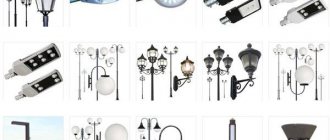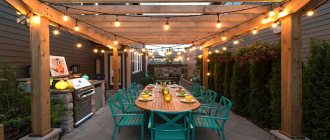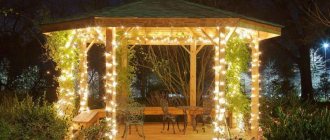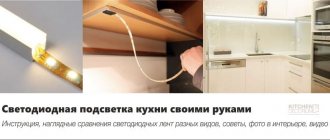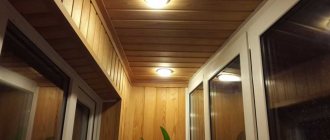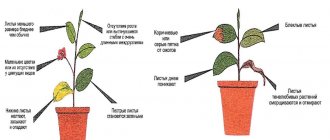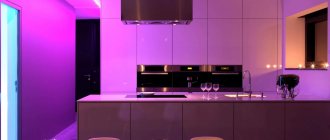Among the various types of landscape lighting, path lighting is organized most often. This is not surprising, because it is important to distinguish the path in front of you in the thickening twilight even in your own area. Let's figure out what options exist for lighting paths in a dacha, what kinds of lamps there are, and what requirements are placed on them.
Beautiful and convenient Source pinimg.com
Requirements
Before planning garden lighting, you should decide on the main functions that are assigned to it.
Unlike other types of street lighting, special requirements are imposed on path lighting:
- The luminous flux from lighting fixtures should clearly highlight the boundaries of the site and the sidewalk.
- Street lights for the garden path should be located significantly below eye level and should not dazzle people moving along it.
- Due to the location of garden lanterns directly in the open air, they are exposed to direct exposure to all atmospheric precipitation, therefore the degree of dust and moisture resistance is selected with a value from IP57 to IP68.
- Must correspond to the temperature conditions within which the street lighting device will be operated.
- The external parameters of artificial lighting should fit harmoniously into the landscape design of the garden, both in the dark and in the daytime.
- Due to the long operation of the lighting design, it is necessary to ensure that the energy consumption is as low as possible, otherwise its work will cost a lot of money.
Functionality versus aesthetics
At the dacha, the main role of lighting is to provide maximum illumination of all necessary locations on the site. At the same time, they try to optimally squeeze the functional side into an aesthetic framework. Functional lighting is a good option for those for whom the main purpose of lighting is safe movement and the ability to access any part of the site, even at night. Garden lanterns, outdoor floor lamps and ballards are ideal for these purposes.
The main task of decorative lighting is to create a unique lighting complex that will naturally fit into and complement the landscape design. Decorative lighting fixtures serve as decoration and addition to paths. This could be: decorative lanterns and figurines, stones and ribbons, lighting of bushes and trees, etc.
Backlight options
All landscape lighting, depending on the tasks set, can be divided into two large groups: functional and decorative. Let's take a closer look at each of them.
Functional
Functional lighting
The main task of functional lighting is to ensure sufficient visibility in a certain area of the garden plot. Classic street lights with a small leg or installed in the ground are suitable for this. Structurally, at the top of the lighting fixtures there is a flat reflector that directs the light down. Some models are equipped with diffuser-type lampshades, which create a uniform distribution of flow in the surrounding space.
Additionally, in addition to garden design, lighting of pedestrian paths can be combined with the main lighting of the area on high floor lamps. It can also combine the functions of emergency or security lighting.
Decorative
Decorative lighting
Decorative lighting is intended not so much to increase visibility within the path and landscape objects, but to create a decorative effect. Lamps for decorative lighting have a fairly wide selection of both design and color variations; there are models made in the shape of fairy-tale characters. They do not differ in significant brightness of the glow, since they highlight only the contours of surrounding objects or are themselves beacons of the existing landscape.
Types of lighting
Garden lighting can be divided into several types: technical (functional), decorative, security, and architectural.
If you decide to make your own garden lighting, you need to remember that technical lighting is done at a certain height, but not too high, so as not to disturb the comfort. An example of technical lighting is lights at the gate. The light should fall from top to bottom.
Decorative lighting should highlight the advantages of landscape design and complement it with new colors. This lighting is usually installed in recreation areas, near alpine slides, and ponds. After all, just one backlight can completely change the picture of the garden.
Security lighting serves for protection and creates the effect of the presence of people. This lighting can be divided into 2 types. In the first type, the lighting automatically turns on at night (photocells turn it on and off). In the second case, the lighting turns on at the slightest movement (motion sensors are installed here).
Architectural lighting, as a rule, not only illuminates the house, but also combines technical and decorative functions. Also see possible options for architectural lighting of houses on the website https://ekodis.com/stati/240-novogodnee-osveshchenie
Selection of light bulbs
Due to the fact that lighting a personal plot is quite an expensive pleasure, the type of light bulbs plays an important role, as it determines the efficiency of the device and other operating parameters. Efficiency refers to the amount of luminous flux produced per watt of electricity consumed.
The most common options for outdoor garden path lighting are:
- Incandescent lamps have a fairly low efficiency - about 8 - 10 Lm/W. Most of the electricity is spent on heating the coil (about 95%), and the rest is used for light emission. The advantages of such light bulbs include their low cost, but their service life is about 1000 - 2000 hours.
Incandescent lamp
- Halogen lamps work by heating the coil inside an inert gas, which promotes better light output. Their performance is about 10 - 18 Lm/W, and their service life is about 4000 hours. The advantages of halogen light bulbs include their low cost.
Halogen lamps
- Luminescent - they work due to the ionization of mercury vapor in a sealed flask, they are capable of delivering about 25 - 50 lm / W, the service life is about 5000 hours. The disadvantages of fluorescent light bulbs include their significantly higher cost and operating temperature limits. Since they may not light up when the thermometer readings are negative, they are used to illuminate paths only in the warm season or in the appropriate climate zone.
Fluorescent lamps
- Sodium lamps are also a variant of gas-discharge lamps, but ionization occurs in sodium vapor. One of the most profitable options for path lighting, as they produce about 90 - 110 Lm/W and can last about 30,000 hours. The disadvantage of such devices for lighting pedestrian areas is their cost. And color rendering parameters.
Sodium lamp
- LED lamps - produce luminous flux due to the diffusion of particles in semiconductor elements. They have the best light transmission for path lighting - about 90 - 120 Lm/W, their service life is about 50,000 hours. Unlike the above options, they are not afraid of depressurization of the flask. The disadvantages include high cost.
LED lamp
The choice of a specific model for lighting garden paths depends only on your needs. For example, in a country house where you visit only on weekends, you can easily use incandescent and halogen lamps, but in places where you use them every day, it is better to give preference to LED or sodium types.
Festive decorative lighting of the site
Many owners of country cottages often carry out non-standard decorative lighting on the eve of holidays (New Year, Easter, March 8). To create a special atmosphere, you can use the following types of lamps:
Fairy lights
They can be completely wrapped around trees or used to stylize the facade: placed above window openings, along the perimeter of the roof. For trees, garlands in the form of thin sticks with LEDs inside can also be used.
Grids with LEDs (a subtype of modern garlands)
They can be fixed in flower beds or placed on the walls of the house.
Glowing figures
They are a metal frame supplemented with LEDs. They produce a bright, soft light, allowing you to illuminate a small area around you. There are also small figures (in the form of New Year's wreaths, flowers or flat silhouettes) that can be mounted on the facade for festive lighting.
Choosing a place to install lamps
Depending on the location of the lighting of garden paths, there are three main positions: on the path itself, on the side of the road, on decorative elements of the garden. Each of them has its own criteria for choosing equipment and its parameters. Let's look at each of them in more detail.
On the track
On the path
If the installation of lanterns is planned directly within the path, they are made of small sizes. Size is especially important for recessed lighting fixtures, which are arranged like LED tiles or LED strips.
Such models must have increased strength, since they will absorb the full load from pedestrian traffic. At the same time, they are of a decorative type, so they do not require high brightness and directional flow of light, otherwise the lighting will blind those passing along the path and the surrounding space will seem even darker.
On the side of the road
Near the path on the side of the road
If the path is already lined with finishing material and there is no desire to violate its integrity, it is much more profitable to use the free space along the path.
Installation of lamps for this place requires some elevation of the lampshade above the illuminated surface, so any floor lamp, pin or ground-based models are suitable here. An important criterion when choosing them is a sufficient level of illumination in functional areas.
On decorative elements
Illumination of trees
If the garden decor is already rich in a variety of all kinds of details and decorations, you can also use them to illuminate the paths. Such elements can act both as a supporting structure for the lamp and as a lighting device itself.
A popular direction is the installation of indirects - devices that direct the light flux to any object, from which it will subsequently be reflected into the surrounding space. A striking example is the lighting of garden sculptures installed near the path, illumination of facades, illumination of plants and trees. An important criterion is that all these elements must be located in close proximity to the sidewalk so that the light effects on them reach the ground surface.
Examples of using
With a large number of luminous stones, you can completely abandon traditional methods of street lighting. Magic pebbles can be used to decorate the borders of paths, thereby shaping their outline, illuminating the direction and marking the boundaries of the pedestrian zone.
Idea: small glowing stones (crumbs) can be used in the process of laying garden paths - simply add glowing stones to the concrete, thereby creating the effect of a starry sky.
Glowing path of crumbs
Also on our website: lighting of a summer cottage.
In addition to being used for paths, luminous pebbles can be used to decorate flower beds and flower beds, or lay them out on the lawn or near large trees. Such lighting will look very harmonious near pools and ponds, as well as near recreation areas.
Plant lighting
It’s very easy to make glow-in-the-dark paths in your dacha with your own hands. Options for decorating a site using luminous elements are limited only by your imagination. With the help of such original crafts, the territory of the house will be filled with a magical atmosphere and bright colors!
From this video you will learn how to make a phosphor with your own hands.
Circuit examples
Before starting installation work, it is important to arrange proper lighting on the site, taking into account the main and secondary paths. First, you will need a site plan with markings of the main landscape elements and buildings. The plan marks the installation points of the lamps and the radius of illumination or the coverage area of the luminous flux. An example of such a plan is shown in the figure below:
Examples of path lighting schemes
When choosing the power and coverage radius of a specific lamp, keep in mind that the functional lighting of the main paths differs from the illumination of additional paths.
For example, the central alley of the garden should be illuminated by more powerful devices; lighting fixtures should be installed in larger quantities. Side paths and driveways do not need to provide as much visibility, so less powerful units are suitable.
Also, when designing a scheme, you need to take into account the flow from floodlights aimed at the paths, architectural lighting and lighting of artificial reservoirs. In these locations, additional lighting may be unnecessary, since the light from these lamps will be more than enough. And together they can significantly worsen the decorative effect and lead to unnecessary energy consumption.
Combined lighting scheme
As you can see in the figure, the lighting of the main path is indicated by yellow circles; in places where the lamps of the pond, flower beds and facade block the pedestrian part, they do not need to be installed.
Common Mistakes
Some garden owners carry out electrical work without drawing up a diagram, which leads to short circuits and other consequences.
Cheap lanterns and lamps that are purchased to save money cannot withstand the load.
The installation material is purchased without reserve, the cable cross-section is calculated incorrectly, low-voltage and power wires, aluminum and copper conductors are connected in one distribution box.
The work is carried out under voltage, but even replacing a lamp can cause a short circuit in a suburban area and cause a fire in the house.
Installation process step by step
If you are just making a sidewalk or finishing a finished base, you can install lamps directly into the path itself. For this:
- Prepare holes according to the dimensions of the lighting fixture - it is more convenient to do this at the laying stage in order to pour a rigid form into the concrete.
Prepare a hole for the lamp
- Draw a power supply line to each of the lamps - it is also more convenient to install the cable filling at the stage of pouring the base.
Route the cable to the lamp
- Prepare an adhesive solution for natural stone - in this example, the path will be finished with stone, so it is important that the adhesive base is designed for the minimum and maximum temperatures in your region.
Prepare a glue solution
- Connect the lamps and install them in the appropriate niches.
Place lamps in niches
- Glue stone tiles around the light fixtures.
Glue the stone tiles
If the path is already installed and no modernization is expected for it, lighting fixtures can be installed on the side of the road next to it. To do this you will need:
- Dig holes where the posts will be installed and connect them with a cable trench.
Connect with a trench
- Pass the cable through the protective sheath and lay it in the trench (in our example, the watering hose plays the role of protection; it perfectly protects from moisture).
Lay the cable in the ground
- Install the posts, since in our case they consist of pipes and bricks, they also need to be laid out.
Install the posts
- Cement the supply line in the ground, this will create additional protection from both moisture and mechanical damage.
Cement the cable
- Install the lampshade and screw in the light bulb.
Install the lampshade and screw in the light bulb.
The lighting for the garden path is ready; in our example, an RGB LED lamp is used. Due to this, you can provide festive lighting from a remote control.
Festive lighting
How to do it yourself
You can install lighting in your dacha yourself if you have a diagram, the necessary materials, tools, and lamps.
Design
When developing a system for a garden plot, devices are selected, the option of their installation, the cable laying method are determined, and the amount of consumables is calculated.
Selection of tools and components
The lamps used must fit harmoniously into the landscape, withstand temperature fluctuations, and be protected from moisture.
To automatically turn on devices and save energy, you need to purchase rheostats and motion sensors.
You definitely need to buy terminals, pipes, and parts that are used to create a circuit for transmitting current.
Choosing a cable laying method
Installation of wiring in a summer cottage is organized underground or performed at height. The first method is safe because the risk of system damage is minimal. However, it is easier to lay the cable over the air and install the distribution board in the house.
Installation instructions
Connections of wires, twisted with pliers and wrapped with insulating tape, are placed in junction boxes. The cable installed on the house is laid in a corrugated sleeve. To avoid the need for additional poles, use a galvanized cable. Wires carrying current must be protected with double insulation. The voltage used in everyday life is 220 V. A regular outlet is suitable for connecting to the network. You can determine the neutral wire with an indicator.
Tips and tricks
When choosing and operating garden path lighting devices, pay attention to the following tips:
- Do not use cheap equipment options - their low quality will force you to quickly look for a replacement;
- To save money, use solar-powered models, although in the second half of the night the light will dim significantly and they will only be enough for marking lighting;
- If you use lamps for both functional lighting of paths and for decoration, select them in the same style;
- Place all communications for powering light bulbs underground so that they do not interfere with the design;
- If you want to create economical lighting for garden paths, use a motion sensor and a photo relay - the first will turn on the lighting only for passers-by, and the second only in the dark.
Types of lamps for garden lanterns
Modern garden lanterns use different types of bulbs; when choosing a suitable option, you have to evaluate their parameters comprehensively: not only power, but also brightness and service life. You can choose between the following lamps:
- Incandescent lamps. Traditional light source; is considered economically ineffective, since most of the energy consumed goes not into light, but into heat. The service life is also not impressive - 1000 hours. Despite the obvious disadvantages, incandescent bulbs are still used in most garden lights. Obviously, the force of habit and the budget cost have an effect.
Path to the house Source hzcdn.com
17 million m2 of land were returned to Vyacheslav Tsepovyaz
Mash reports this
Tsepovyaz’s wife was also released from house arrest and one of the cases of extortion worth 70 million rubles was closed
I don't know why I didn't read this on pikabu, maybe the smart feed is to blame..
But I refuse to understand how the murderers and extortionists could get back what was taken away through murder and extortion. I can’t understand why the Prosecutor’s Office does not react in any way to the arbitrariness of the judicial system in Rostov.
All I can say about this is illegal, unfortunately.
The racist card didn't work
Kind. There have been cases when they tried to accuse me of racism, sexism, ageism (this is when I refuse to sell knives to children), and even communism. All isms, worse. If the isms were Pokemon, I would definitely have gathered them all by now.
But there are also shots that amaze with their absurdity (K - client):
K - Hey dude, you have awesome knives! Are you sending to the USA?
I - Hey, yes. Did you like anything in particular?)
K - Your tanto that you are playing is just a plague! I just can’t live without him now. But the prices in your store are insane. How about a little deal: I give you $200, and you give me this tanto?
Me - Um, do you want me to give a 90% discount? Raw materials alone cost $600 here.
K - No, you don’t understand. You're giving it away for free, right? Just make sure I get the knife and you get $200 and you're all in the black.
Me - Hmm, an extremely tempting offer, but I’ll refuse it.
K - Dude, 200 dollars is better than 0, don't be an idiot, bro.
I - Aaaand, welcome to the blacklist.
K - What are you doing? Are you fucking kidding me! Is it because I'm black?
Me - You were blacklisted because you are a smart-ass freeloader. And extremely rude. I don't care about skin color. And even if it didn’t matter: dude, your page is closed. I have no idea who you are.
K - Who are you calling a freeloader? Yes, I will destroy your fucking store to the ground.
Me - Oh yes, break me completely.
K-Ahahaha, eat shit you stupid cunt
Me - Do you understand that it doesn’t work like that? Can't you play the racist and homophobic card at the same time?
Me - With pleasure, baby.
I just don't understand it, to be honest. I even grunted like a bitch at the outcome of this dialogue.
Thank you all for your attention and enjoy the thrill!
Creating a cozy corner for relaxation
Today we will look at some interesting ideas on how to make your garden plot even more attractive and original.
Table and chairs made of hemp
To implement the idea, you will need to stock up on wooden sections from strong wood (oak, ash, walnut) and the proper set of tools.
Each workpiece must be trimmed with a plane, the top surface must be sanded, and coated with primer and varnish in several layers. The right approach to creating a garden table will ensure long service life of the products in the country.
Table and chairs made of hewn boulders
Stone chairs in the garden are used in several styles of landscape design, but any summer resident can create such a rocky interior on his own.
Prepare a flat area, clear the ground of possible roots and metal debris. Place the main boulder table in the center of the prepared area. You will have to work a little on sanding the tabletop. Place chairs made of stones around.
In Moscow, guests of a pub were served regular canned Baltika instead of elite Kennedy Beer.
In Moscow, a scandal is breaking out around the “Yellow Raccoon” pub on Arbat. An employee of the establishment accused its owners of deceiving visitors and serving ordinary canned Baltika beer instead of elite Canadian beer from the USA.
Former employee of the “Yellow Raccoon” Evgeniy M. revealed a scheme on his social networks: the pub bought Baltika in bulk, and then the employees used grinders to completely remove all the images and markings from the cans. The name of the CAN craft brewery from Sideington, South Dakota was applied to the “naked” beer container by transfer printing. In reality, neither such an enterprise nor even this city exists. The supposedly “elite” beer was sold to visitors for 1,099 rubles per can, serving it as a drink for connoisseurs; on the menu it was listed literally like this: “Craft limited edition canned beer CAN (USA).”
“The place was popular in certain circles; there were even people more or less knowledgeable about beer, authors of thematic blogs, and gourmets. No one noticed the catch, they drank and praised it, talked about some notes of almond and all that. The guy who was at the counter took a very long time to learn not to laugh out loud when he heard all this. When they said that Americans know how to brew beer, not like domestic piss, I couldn’t stand it and went into the back room to yell,” added the author of the post.
Evgeny suggested that his publication be considered a statement to Rospotrebnadzor and stated that he would be ready to testify against the management of “Yellow Raccoon”. Two weeks before, he was allegedly fired without paying his salary for a month and a half; now the young man intends to sue the establishment.
Video example of the work result
The appearance of the lamps should be in harmony with the design of the surrounding space. The abundance of decorative elements and light play, combined with numerous delights, will overload the visual perception and create an irritating feeling of chaos. In this case, it is better to use simple or hidden light sources. But a strict landscape can be diversified with stylish lamps of unusual shapes.
- Author: Shandi
Rate this article:
- 5
- 4
- 3
- 2
- 1
(2 votes, average: 3 out of 5)
Share with your friends!
Photo ideas
And finally, I would like to present to your attention some interesting photo ideas for creating path lighting with your own hands:
